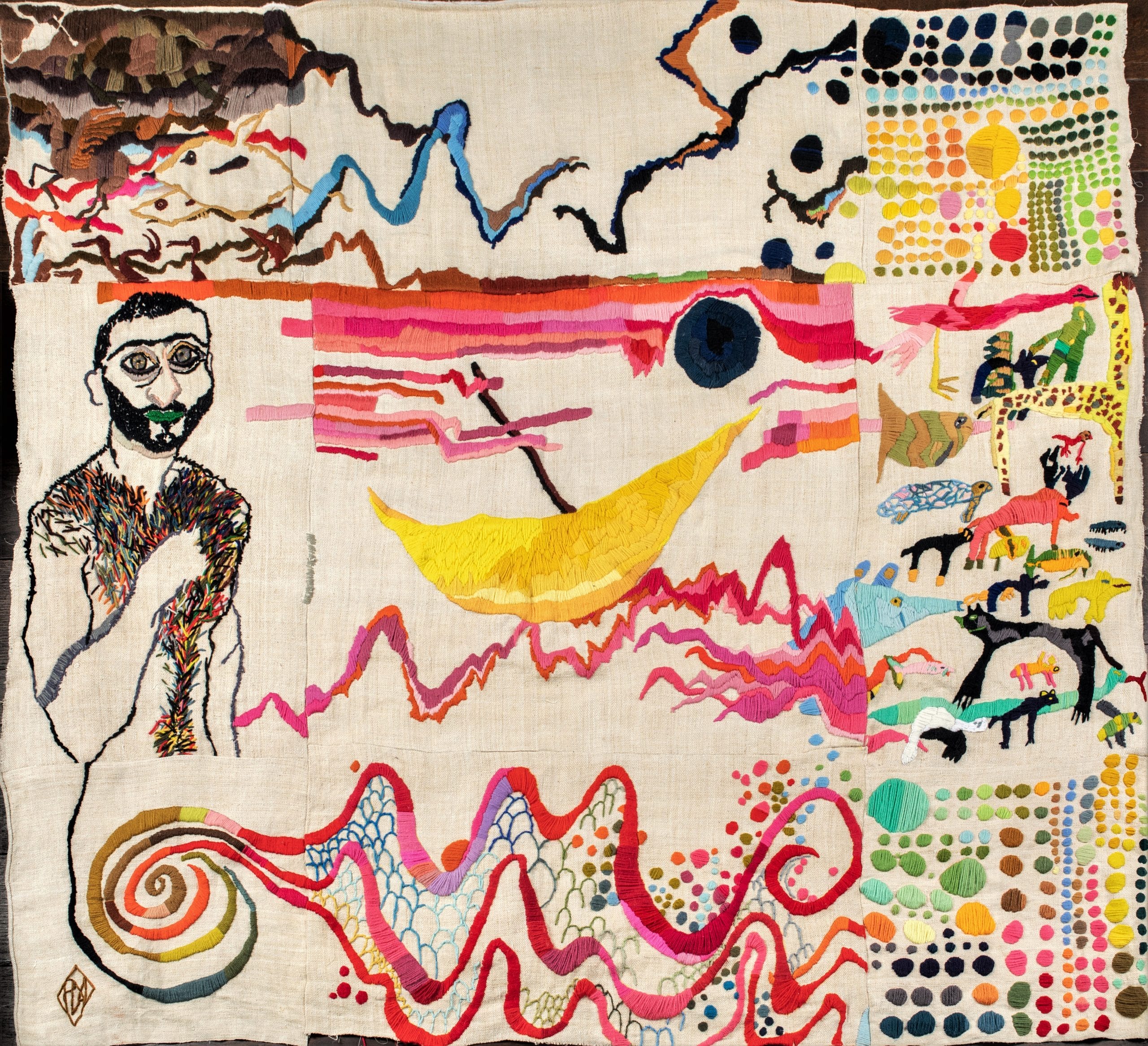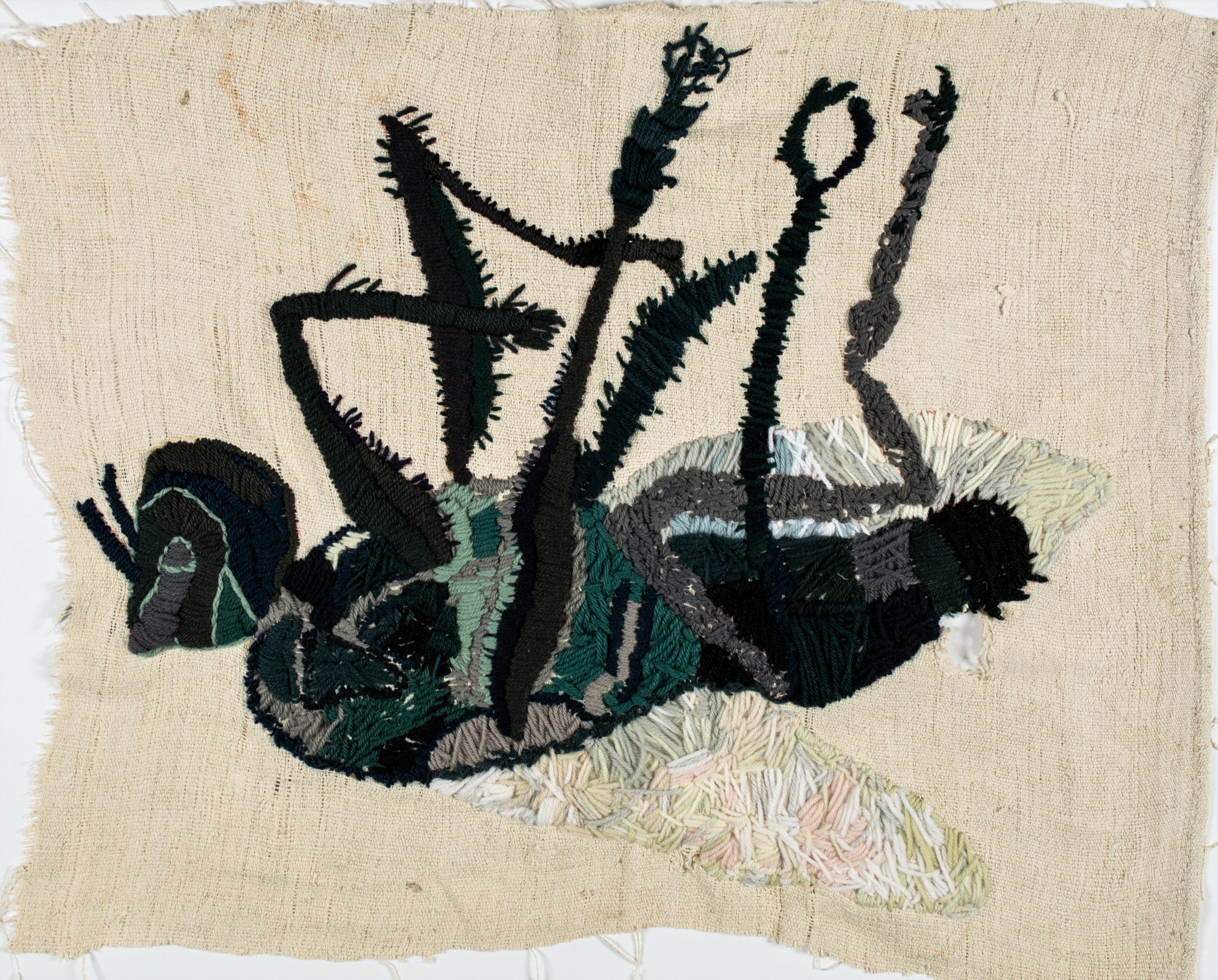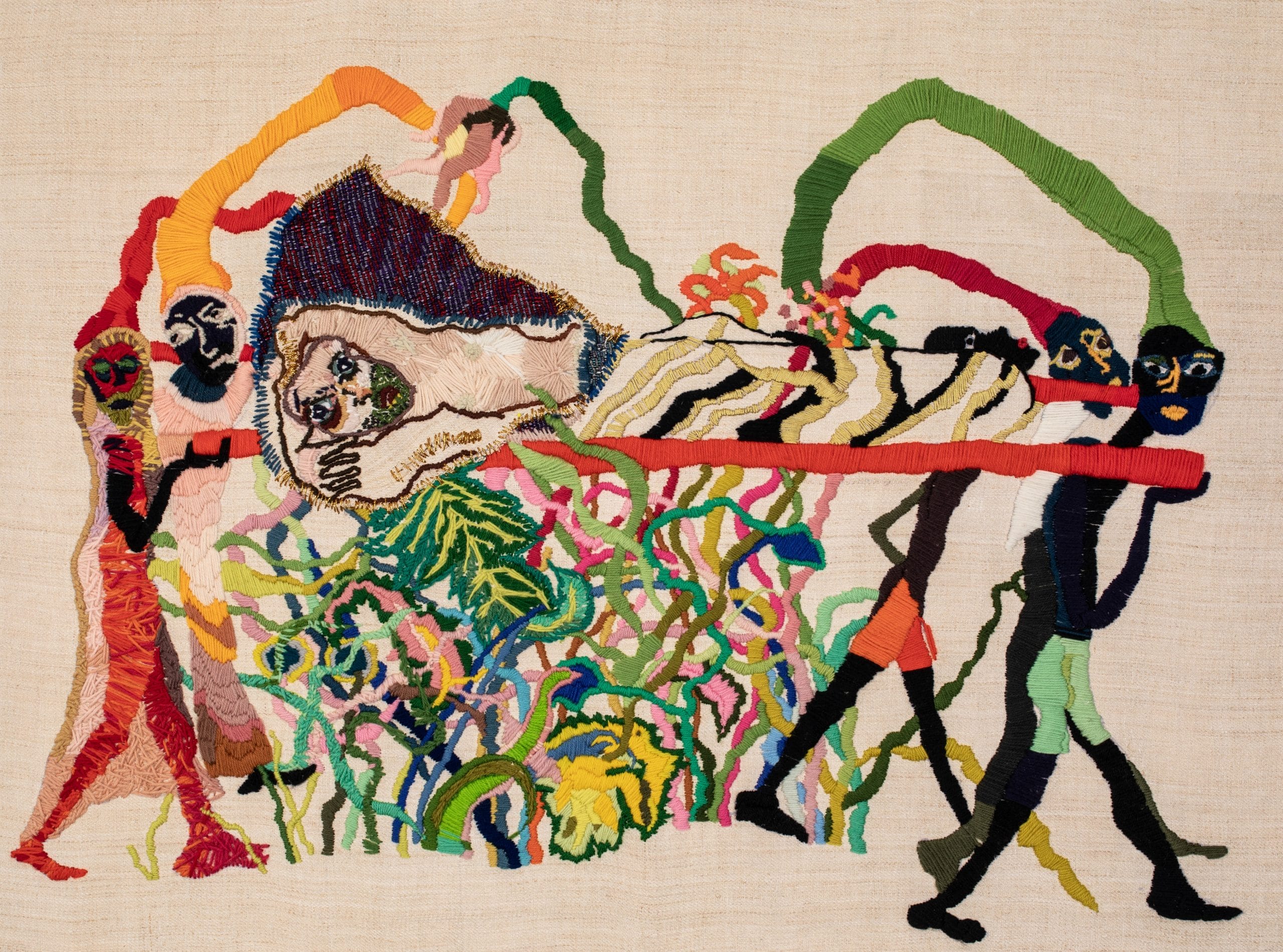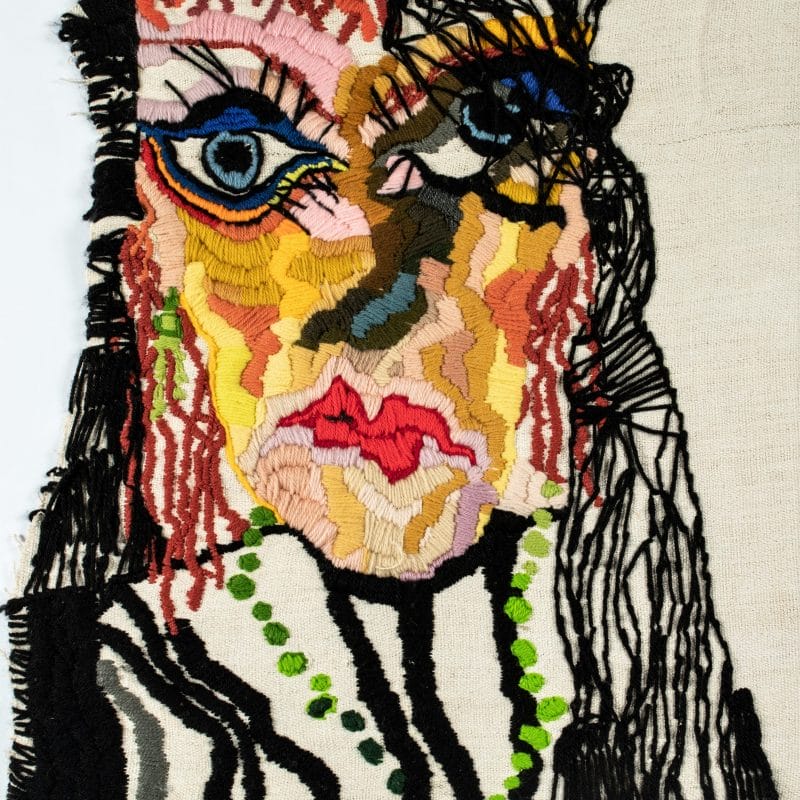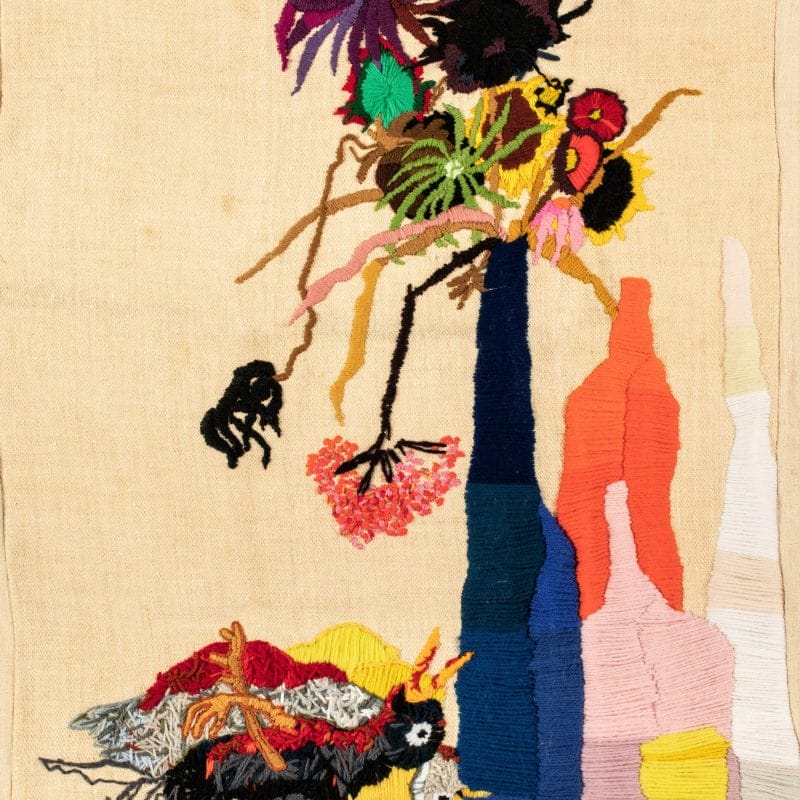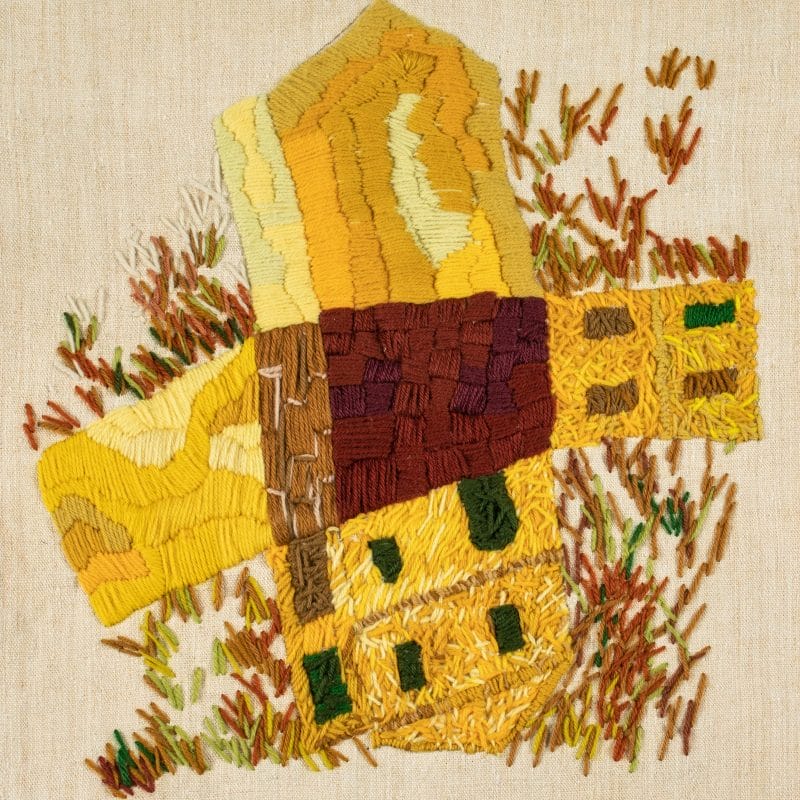Interview with Pascal Monteil
Translation by Marina Dlacic
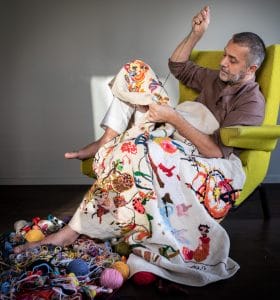
Pascal Monteil was born in Nimes in 1968. Growing up in a small wine village in the south of France, he graduated from the Ecole Superieure d’Art de Cergy Pontoise, inherited from his parents the passion for travel and for over thirty years he lived in many countries of Asia, from Turkey, India, Japan, Iran.
His tapestries are a layered narrative in which poetry, literature, traditions, history and stories of different peoples and eras coexist, told through rigorous craftsmanship that combines love for culture and passion for manual skills. An artistic practice that becomes a philosophy of life, cultivated thanks to a vision of the world that feeds on curiosity and interest in everything that surrounds us and that preceded us… and lived with great joy.
Pascal Monteil, Noé, 2019, 170 x 180 cm, ©Célia Pernot, courtesy galerie Regala
How was your interest in textile art born?
I have stayed a lot in India, Bangladesh, Iran, Japan over the past twenty years.
One day on the way to Tabriz, Iran, I sat for a whole afternoon in a patio with men repairing a huge carpet. I envied their calm, their slowness and told myself that I wanted to belong to this community of men.
A few years later, for a commissioned work, I wanted to represent an exile, that of the Spanish Jews in 1492. To represent the exiles I needed a nomadic technique, to feel with them, in my imagination, on the streets, opening and closing my canvas on a boat or in a field of olive trees and I thought about fabrics. I told myself that I would take up the Bayeux tapestry technique.
Embroider on canvas. Use my needle as if it were a brush and my threads as if they were tubes of paint.
Pascal Monteil, Nature Boy, 2020, 100 x 140 cm, ©Célia Pernot, courtesy galerie Regala
You have traveled the world learning techniques and knowing cultures. How is this wealth of knowledge expressed in your works?
Oddly, I haven’t learned any embroidery techniques overseas.
Culturally, however, I got tired of the overlapping of cultures, of thoughts. The world for me is a tower of Babel with contradictory thoughts, eras that overlap.
This is what makes me happy. It is this intersection and this superimposition of cultures that I try to make appear in my works.
What are your main sources of inspiration?
I think back to Indian temples, to the sweet madness of the streets of Calcutta, to a patio in Isfahan, or to a lost monastery in Armenia and I tell stories that I embroider …
The history of religions, the ways of exile are themes that haunt me because they have animated the world since the dawn of time. The vulnerability of men, their search for the sacred … their inner and physical journeys on the streets to find a space where they can live. A shelter.
Pascal Monteil, Mouche morte, 2017, 54 x 68 cm, © Célia Pernot, courtesy Galerie Regala
Your works are complex and very heterogeneous stories. What do you tell in your works? What would you like them to convey to the public?
I would like them to convey the complexity and poetry of the world.
I wish they had the joy, the melancholy, the richness of a Lorca poem or a Pasolini film.
I read a lot, I immerse myself in the history of Art, the Persian miniatures, the Viennese, Klimt, Schiele, Hundertwasser, the Italians, Giotto, Morandi, Pasolini, Sottsass … they are fathers with whom I interact … with whom I live and who allow me to look at the world with poetry. I would like to give those who look at my tapestries a little of this sensuality and this poetry
Wool and ancient fabrics. Why did you choose these materials for your works?
Yes, I use hemp canvas woven on farms in southwestern France a century ago. For the wool now that I live in Arles I use Merino sheep wool from the Camargue which is spun and dyed with flowers and roots in the hills a few kilometers away.
The madness of technology, the speed of the world are things that weigh on me. I chose a slow, archaic technique, a simple tool to counter this frenzy.

Pascal Monteil, Médée, 2017, 105 x 29 cm, © Célia Pernot, courtesy Galerie Regala
And in fact, embroidery is a slow technique that requires the repetition of gestures. Is it fundamentally also a meditative exercise? How long does it take on average to complete a tapestry?
Yes for me it has become an essential gesture, which leads me to a form of meditation. I embroider almost every day from two in the afternoon until one in the morning. I need this time, this repetition, these variations. It’s a life style.
My first tapestry measuring 1 x 3 meters took me a year of work. Each tapestry requires, depending on its size, three or four months of work, sometimes more …
For me to embroider is to paint slowly
All the work in your works is done strictly by hand. Is the manual, artisanal figure of the works important to you?
I come from families of winemakers from the south of France and from the other side of Italian bakers. This lineage from manual work is very important to me.
I studied in very contemporary art schools in Nice, where handwork was not much appreciated. It took me a long time and many trips to rediscover this joy of manual skills, to allow me to simply put my hands in communication with my mind.
Pascal Monteil, La civière de Rimbaud, 2019, 89 x 114 cm, ©Célia Pernot, courtesy galerie Regala
From the idea to the finished tapestry, what is the genesis of your works? Is each work a project in itself or do you proceed by cycles and themes? Do you draw first or do you proceed with the flow of inspiration as you work?
Before starting a tapestry I write a lot for weeks, describe the characters, their clothes, what they think, their desires, their anger, their sadness, what they eat, where they sleep … as a writer or a director. And when all my characters live in my head, when my mental image is clear, alive, I can start embroidering… to make them appear on the canvas.
What are your projects for the near future?
I am currently working on a commission for a four meter long embroidered tapestry. It will be a banquet where I invite the writers, painters, literary men I love… those mentioned above.
Like a contemporary Supper or Wedding at Cana …
I am also working on cardboard for a low-heddle tapestry project that would be made in a factory in Aubusson. If this project is realized, it will be the discovery with the artisans of another technique with the loom and of teamwork.

